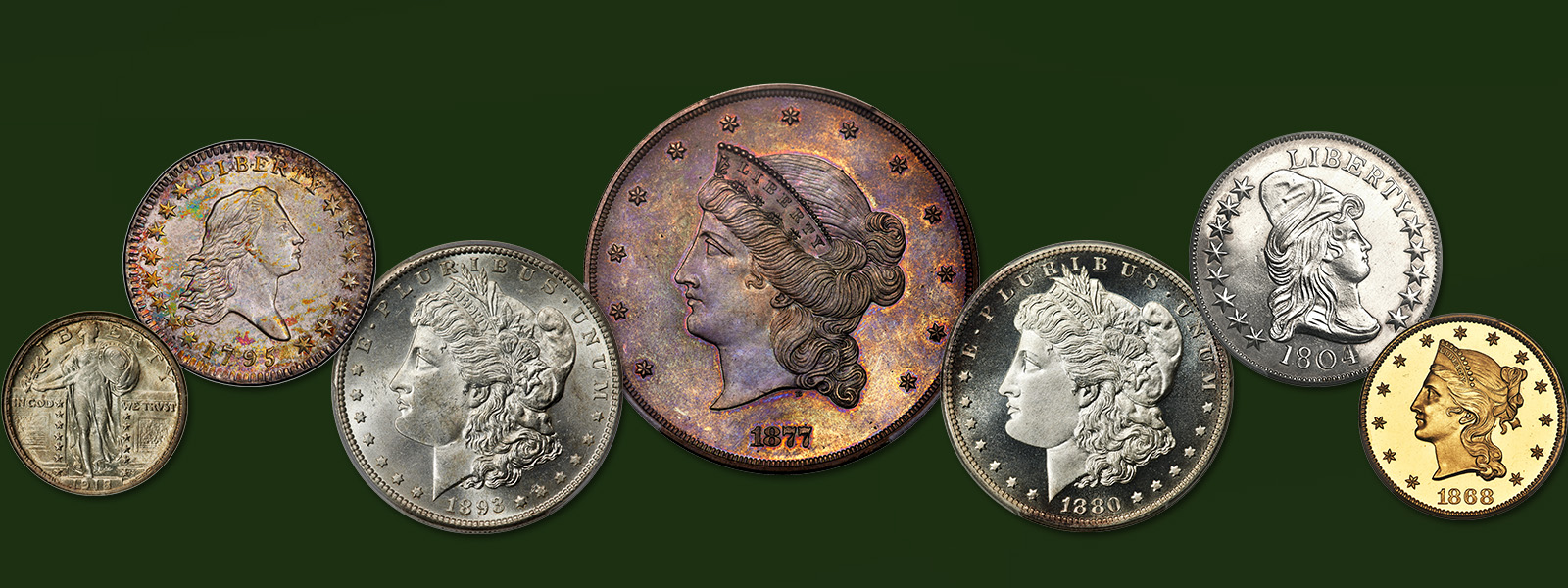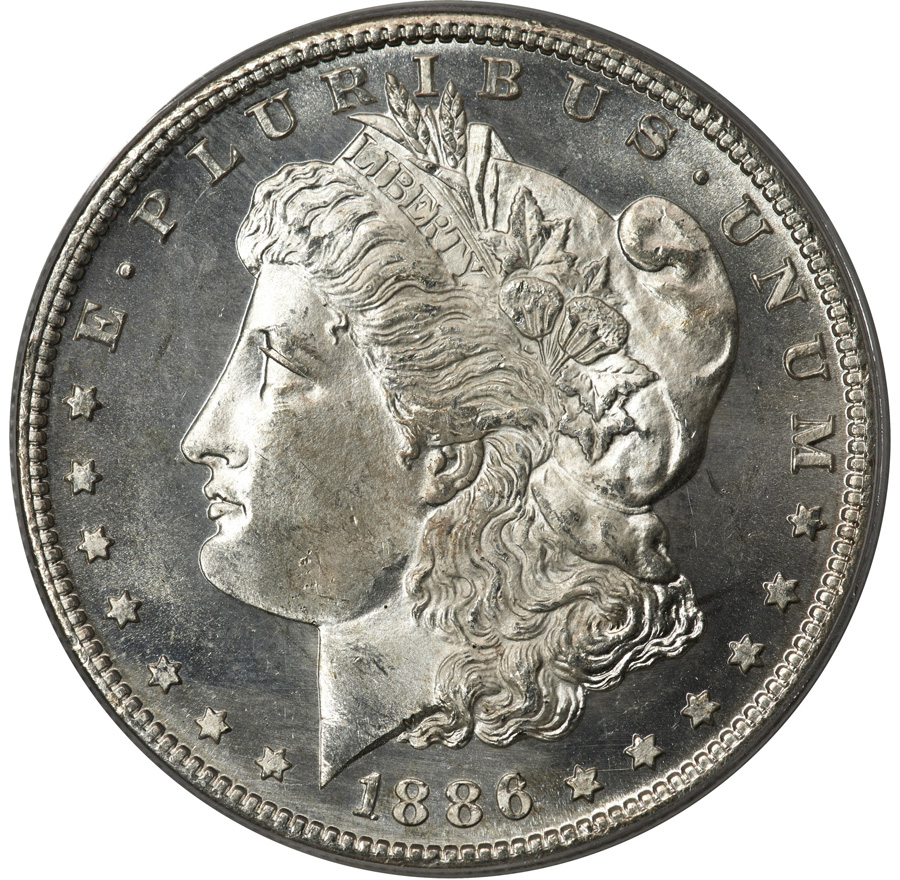CERTIFICATION CAN BE AN IMPORTANT PART OF EVALUATING A COLLECTION, BUT THERE ARE FACTORS TO CONSIDER BEFORE TAKING THAT STEP
This 1853 gold dollar, graded MS69 by PCGS, realized $264,000 in a January 2024 Heritage auction. According to PCGS standards, an MS69 designation means a coin has only minuscule imperfections.
By James Halperin and Greg Rohan
Authenticity and evaluation are vital matters for any coin collection, and third-party grading services are widely available. Use them as needed, but consider the cost, quality and value of grading services for your coins. For many items, especially lesser-valued pieces, grading may not be necessary.
The American Numismatic Association adopted Dr. William Sheldon’s 70-point grading system and, between 1973 and 1977, worked to establish standards for all series under the leadership of numismatic luminary Abe Kosoff. Experts from all coin specialties collaborated with Kosoff to develop the first official ANA grading guide, published in 1978.
Initially, it recognized three grades to evaluate Mint State coins: Uncirculated or MS60; Choice Uncirculated or MS65; and Perfect Uncirculated or MS70. Unfortunately, the third grade (MS70) was mostly theoretical, and the two remaining designations quickly proved inadequate for the marketplace. MS63 (Select Uncirculated) and MS67 (Gem Uncirculated) were added to the system and functioned successfully for a while until the demand for closer evaluation required additional grades. Eventually, all numbers between MS60 and MS70 were employed and the adjectival equivalents were eliminated.
NGC and PCGS remain the acknowledged leaders for coin grading. The reason for their success is that they are the only firms that have maintained sufficient dealer confidence to allow coins to be traded routinely on a sight-unseen basis.
Graded MS62 by NGC, this Charles II silver Pattern ‘Petition’ Crown 1663 sold for a record $960,000 in a January 2024 Heritage auction. A coin graded MS62 by NGC has a slightly weak or average strike with no trace of wear, with more or larger abrasions than a specimen that has earned an MS63 designation.
What Should You Certify?
Certification is an expensive proposition that should be approached with caution. At $15 and up per item, the total costs – for even a small collection – easily can run into the thousands of dollars. Not all collectibles benefit equally from being certified. The rule of thumb, of course, is that the finished product must be worth more than the raw (ungraded) item, plus the certification fee.
There are two practical reasons to certify a coin: to determine authenticity and to add value.
When a dealer considers buying an uncertified coin, the guess is how the grading service is going to grade it – and the dealer will want to be as conservative as possible. For example, if a dealer is looking at your 1886-O Morgan dollar and trying to decide whether NGC will grade it an MS63 (valued at, say, $3,000) or MS64 (valued at $10,000), it will be designated as an MS63 coin, to be on the safe side, and the dealer will offer a price commensurate with an MS63 coin.
You could, however, have the coin certified before attempting to sell it. The upside is that if the grading service calls it an MS64, you have a five-figure coin. The downside is the cost of the grading fee. The bottom line is that this issue has a significant value spread between grades and – in our opinion – the risk is worth the expense.
In one January 2024 Heritage auction, an 1886-S Morgan dollar graded MS64 realized $6,300. In the same auction, another 1886-S Morgan dollar, this one graded MS66, sold for $10,500.
Submitting Your Coins
NGC and PCGS operate primarily through authorized dealer networks, though both offer programs through which collectors can directly submit coins to the grading services. Most of these dealers frequently will submit your coins to the grading services on your behalf. The dealer often is compensated with a rebate of approximately 20 percent of the grading fee. Don’t request part of the rebate, but do ask for the coins to be previewed and for help determining which coins to submit for certification. Most authorized dealers are familiar with the standards of both grading services and can help you avoid coin submissions on which third-party grading may not add value.
If you reside within driving distance of an authorized dealer, make an appointment to preview the coins with them. If you are not within a reasonable distance, you may ship your coins to an authorized dealer of your choice. A good rule of thumb is to select an authorized dealer who is also a member of the Professional Numismatists Guild. The PNG is the most respected numismatic fraternal organization, and each new candidate must undergo a detailed background check and be approved by the entire membership. Members must conduct themselves under a strict code of ethics and submit to binding arbitration in the event of disputes.
Declaring Submission Value for Insurance
When you prepare to submit your coins for grading, you will be asked to declare a value for insurance purposes. This is important should the package become lost or the items damaged in transit or at the grading service. Since grading and shipping fees both are impacted by this decision, you need to determine whether the value range is commensurate with the likelihood of loss or damage, and then select a replacement value for the items.
Third-party grading can be an extremely important part of estate planning. Certification by a reputable grading system will increase the liquidity of a collection when it is sold because certified coins are easy to trade among dealers and on the Internet. And your heirs and advisors will be spared the burden of extensive (and expensive) identification and cataloging. In short, third-party grading will protect your coins, allow your heirs to value and identify them, and provide liquidity when the collection is sold.
This article is excerpted from The Collector’s Handbook: Tax Planning, Strategy and Estate Advice for Collectors and Their Heirs.
 JAMES HALPERIN is Co-Chairman and Co-Founder of Heritage Auctions.
JAMES HALPERIN is Co-Chairman and Co-Founder of Heritage Auctions. GREG ROHAN is President of Heritage Auctions.
GREG ROHAN is President of Heritage Auctions.




